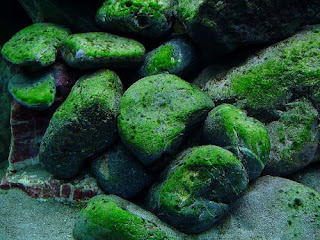Algae: The Leading Cause of Fish Deaths in Ponds
By Clifford WoodsFish pond algae are really a general name which represents all of the various types of algae, normally present in ponds. A few varieties of algae can actually be beneficial to the overall health of the pond while others types can be viewed as a real annoyance.
You will need to prevent as many algae blooms as you can in order to keep your fish and visual appealing pond vegetation alive.
 The most prevalent type is the floating green algae, like chlorella, euglena, and chlamydomonas varieties. They grow and reproduce quickly through cell division or spores.
The most prevalent type is the floating green algae, like chlorella, euglena, and chlamydomonas varieties. They grow and reproduce quickly through cell division or spores.
Filamentous algae, also known as string algae, appear to be lengthy green noodles and have a hair-like visual aspect to them. The looks are a result of a combination of cells joined up end to end. Horse hair algae and blanket weed types like spirogyra, oedogonium, and cladophora are quite prevalent.
The Factors That Lead to Pond Algae Growth: The main three variables that enables pond algae to produce consists of: hot temperatures, vitamin abundant pond water, and crystal clear pond water that permits sunshine to pass through. A rise in temperatures speeds up both blanket weed and suspended green algae advancement.
How Various Algae Varieties Affect the Overall Health of the Fish Pond: Floating plank-tonic algae distribute at a speedy pace and can only be managed by ultraviolet illumination from a UV sterilizer. The UV spectrum splits the cell surfaces, resulting in the algae to collect together which in turn allows filters to easily remove the algae from the pond. A substantial amount of floating green algae can produce what is known as algae blooms. They could be devastating to pond fish as the blooms will at some point deprive the pond of oxygen thus killing off all underwater plants and fish life.
Why Too Much Algae is Harmful for Garden Ponds: Algae does not just make the pond seem unpleasant and overgrown, but in more severe situations, can actually cause the pond to smell foul. The rotting process of algae eats up oxygen from the pond water. This is especially harmful to the oxidizing bacteria and pond fish population, which both need oxygen to thrive.
Keep in mind that ammonia must be changed into nitrites by the oxidizing microorganisms. The oxidation procedure calls for vast volumes of oxygen to be able to take place. The rise in ammonia, which is additionally created by decaying algae matter, puts even more stress on the pond filtration system that houses the nitrifying bacteria.
How to Control Algae in Your Fish Pond: By far the most effective way of handling suspended plank-tonic algae is to make use of a UV clarifier or UV sterilizer. The ultraviolet spectrum eliminates the single-celled algae, resulting in it expiring and sticking to other deceased algal cells. Make an effort to cover a minimum of one third the surface area of the fish pond with plants, since they contend with algae cells for the accessible vitamins in the pond water.
Conduct regular cleaning by getting rid of string algae and blanket weed by using a garden rake. Not all algae are bad for a fish pond however. In fact, algae can be quite helpful to the pond because it supplies a way to obtain food for fish, presents shade from the sizzling sun, and offers as a shelter from king fishers, heron, along with various other birds.
It really is alright to have a bit of algae on pond surfaces, filtration systems, as well as other pond maintenance gear. The key is to keep it in check with a probiotics solution such as an organic algaecide created with beneficial microorganisms.
* * *
Clifford Woods is the CEO of Effective Environmental Services and Organic Environmental Technology
Find out more about our Natural Products
We brew Beneficial Microorganisms that eat toxins and offer Natural Organic Solutions










